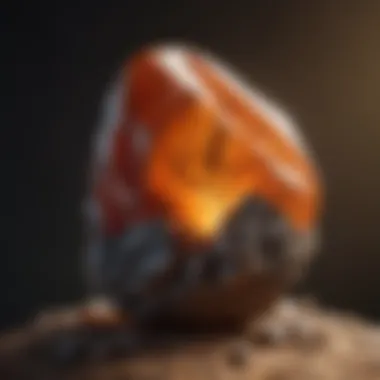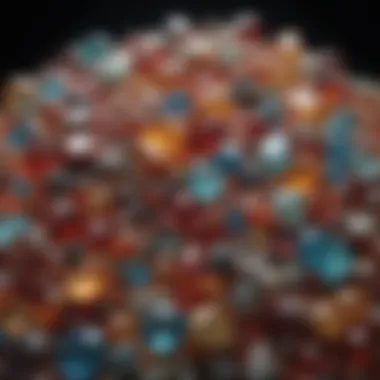Unveiling the Wonders of Rock Tumbler Powder: A Comprehensive Guide


Rock and Fossil Identification
When embarking on the journey of rock tumbling, it is essential to have a keen eye for identifying the types of rocks and fossils that will undergo transformation through the tumbling process. Understanding the distinguishing characteristics of each specimen is crucial in achieving desired results. Various tools, such as magnifying glasses and hardness testers, can aid in the identification process, enabling collectors to discern between different types of rocks and fossils with precision.
Collecting Tips and Techniques
To obtain high-quality specimens for tumbling, collectors must adhere to best practices for collecting rocks and fossils. It is imperative to choose prime collecting sites carefully, where a diverse range of specimens can be found. Following ethical guidelines when extracting specimens ensures sustainable collecting practices. Safety measures should also be considered, especially when dealing with potentially fragile or hazardous materials.
Preservation and Display
Once rocks and fossils have been tumbled and polished to perfection, preservation becomes a key consideration. Utilizing techniques such as sealing or coating can help maintain the luster of the specimens over time. Proper storage methods, involving the use of archival quality materials and avoiding exposure to UV light or moisture, are essential for preserving the integrity of the collection. When it comes to displaying tumbled gems, creativity plays a significant role. Incorporating unique display ideas, such as shadow boxes or themed arrangements, can showcase the beauty of the specimens effectively.
Geological Insights
Delving deeper into the world of rocks and fossils unveils fascinating geological insights. Understanding the formations and processes that led to the creation of these specimens provides valuable context. Exploring the historical significance attached to certain rocks and fossils adds another layer of intrigue to the collection. Notable discoveries within the field of geology offer a glimpse into the wondrous diversity of the earth's rocky treasures, showcasing the marvels that await those passionate about rock and fossil collecting.
Introduction
Rock tumbler powder plays a pivotal role in the intricate process of transforming rough stones into polished gems, unveiling a mesmerizing journey of geological artistry. Understanding this fundamental component is essential for rock and fossil collectors to unlock the true potential of their treasures. This section serves as a gateway to the wonders of rock tumbler powder, offering insights into its composition, effects, and applications throughout the tumbling process.
Unveiling the Magic of Rock Tumbler Powder
The Purpose of Rock Tumbler Powder
In the realm of rock tumbling, the purpose of rock tumbler powder emerges as a crucial catalyst for achieving exquisitely polished stones. Acting as an abrasive agent, this powder facilitates the grinding and smoothing of rough surfaces, gradually revealing the hidden beauty within natural stones. The key characteristic of rock tumbler powder lies in its ability to harmonize the tumbling action while sculpting stones with precision. Despite its abrasiveness, the controlled nature of this powder ensures a meticulous polishing process with minimal erosion, making it a preferred choice among enthusiasts seeking impeccable finishes. The unique feature of rock tumbler powder is its adaptability to various types of rocks, delivering consistent results and enhancing the overall tumbling experience.
Key Components of Tumbler Powder
Comprising a blend of silicon carbide or aluminum oxide, the key components of tumbler powder encompass a synergistic fusion of abrasive elements designed to refine stones efficiently. The granular nature of these components enables them to abrade rough surfaces gently, gradually refining textures and shapes with finesse. Evident advantages of tumbler powder include its efficacy in evening out imperfections, smoothing edges, and achieving remarkable luster on gemstones. However, limitations such as potential over-abrasion and lack of specificity in texture alteration should be considered when harnessing the power of these components. Understanding the nuances of tumbler powder components is essential for optimizing tumbling results and preserving the integrity of valuable specimens.
Historical Significance of Tumbling Powders
Exploring the historical significance of tumbling powders unveils a legacy rooted in ancient lapidary practices and lapidary arts. From the early civilizations of Mesopotamia to the Renaissance lapidaries, the utilization of abrasive powders for shaping and refining stones echoes a timeless tradition of craftsmanship. Tumbling powders have evolved alongside lapidary techniques, contributing significantly to the advancement of gem cutting and polishing methodologies. The historical lineage of tumbling powders underscores their enduring relevance in contemporary rock tumbling, reflecting a profound connection between past traditions and modern lapidary pursuits.


Understanding the Composition
Silicon Carbide vs. Aluminum Oxide
Delving into the composition of rock tumbler powders unveils the distinctive properties of silicon carbide and aluminum oxide as predominant abrasive agents. Silicon carbide, renowned for its hardness and versatility, offers superior abrasive strength suitable for grinding and shaping a wide array of rocks. In contrast, aluminum oxide excels in producing fine finishes and delicate polish on softer stones, making it a preferred choice for achieving refined textures. The juxtaposition of these abrasives highlights the nuanced capabilities each compound brings to the tumbling process, providing collectors with diverse options for customizing their polishing techniques.
Grit Sizes and Their Effects
The varied grit sizes present in tumbler powders play a pivotal role in determining the level of abrasion and finishing precision during the tumbling process. Coarser grit sizes exhibit robust abrasive power, ideal for reshaping and smoothing rough surfaces effectively, while finer grit sizes refine textures with intricate detail and luminous sheen. Understanding the interplay between grit sizes and their effects allows enthusiasts to tailor their tumbling regimen to specific stones, ensuring optimal results and meticulous craftsmanship. By selecting the appropriate grit sizes, collectors can finetune the polishing process to achieve desired finishes that showcase the inherent beauty of each rock.
Specialized Formulas for Different Rocks
Navigating the realm of specialized formulas unveils a spectrum of tailored tumbler powders crafted to address the unique characteristics of distinct rocks. From limestone to quartz, each rock variant demands a specific formulation of tumbler powder optimized for its hardness, density, and mineral composition. These specialized formulas leverage a blend of abrasive components and additives to enhance polishing outcomes, ensuring consistent results across a diverse range of geological specimens. By aligning tumbler powder formulations with the intrinsic attributes of different rocks, collectors can elevate their tumbling endeavors, unveiling bespoke creations that reflect the individuality and splendor of each polished stone.
Types of Rock Tumbler Powder
In this article, the exploration of the wonders of rock tumbler powder is a crucial aspect that unveils the intricate processes involved in transforming rough stones into exquisite gems. Understanding the importance and nuances of different types of rock tumbler powder is fundamental in achieving optimal results in the tumbling process. By delving deep into the specific elements, benefits, and considerations surrounding the various types of powder, enthusiasts and collectors gain valuable insights that enhance their rock tumbling endeavors.
Silicon Carbide Powder
Advantages and Disadvantages
Silicon Carbide powder stands as a pillar in the world of rock tumbling with its distinctive advantages and some inherent disadvantages. The key characteristic of silicon carbide lies in its exceptional hardness and abrasive properties, making it a popular choice for rock tumbling applications. Its aggressive cutting action enables efficient smoothing and shaping of stones, resulting in faster processing times. However, its downside includes a higher cost compared to other alternatives, which may factor into the decision-making process for enthusiasts. Despite this drawback, the benefits of silicon carbide in enhancing the tumbling efficiency and achieving desired polishing outcomes make it a preferred option for avid rock and fossil collectors engaging in lapidary artistry.
Suitability for Various Rocks
The suitability of silicon carbide powder for various rocks is a crucial consideration for rock tumbling enthusiasts looking to achieve specific finishes and polish levels. With its robust abrasive properties, silicon carbide is particularly well-suited for harder rocks like quartz and jasper, enabling efficient material removal while creating smooth, polished surfaces. Its versatility also extends to softer stones, providing adequate cutting power without causing excessive damage. This adaptability across a range of rocks makes silicon carbide powder a versatile and effective choice for rock tumbling applications, catering to the diverse needs and preferences of collectors seeking high-quality finishes.
Aluminum Oxide Powder
Properties and Applications
Aluminum oxide powder offers a contrasting yet equally valuable alternative to silicon carbide in the realm of rock tumbling. Known for its moderate hardness and durability, aluminum oxide provides a gentler approach to stone polishing compared to silicon carbide. The key characteristic of aluminum oxide lies in its ability to produce smoother finishes with less aggressive cutting action, making it suitable for delicate or softer rocks that require a more refined polishing process. This unique feature positions aluminum oxide as an excellent choice for achieving mirror-like finishes on stones where preserving intricate details and textures is paramount, highlighting its practicality and versatility in different tumbling scenarios.
Comparison with Silicon Carbide


When comparing aluminum oxide with silicon carbide, distinctive attributes come to the forefront, shaping their roles in the rock tumbling process. While silicon carbide excels in its abrasive cutting power and efficiency, aluminum oxide prioritizes precision and finesse in achieving polished results. The key characteristic that sets aluminum oxide apart from silicon carbide is its softer abrasive nature, which lends itself well to refining surfaces without excessive material removal. This makes aluminum oxide a preferred option for collectors focusing on intricate design elements and detailed finishes, offering a nuanced approach to rock tumbling that complements the more aggressive nature of silicon carbide.
Cerium Oxide Powder
Specialized Uses in Polishing
Cerium oxide powder caters to specialized polishing needs within the realm of rock tumbling, presenting unique benefits and considerations for enthusiasts. The key characteristic of cerium oxide lies in its ability to achieve high luster and sheen on stones, particularly those with glassy or smooth surfaces that require a mirror-like shine. Its specialized polishing properties make it an ideal choice for final polishing stages, enhancing the visual appeal and overall quality of tumbled stones. While cerium oxide is effective in creating brilliant finishes, careful consideration of its application technique and quantity is essential to optimize outcomes and avoid over-polishing, ensuring that the desired level of shine is achieved without compromising the stone's integrity.
Considerations for Usage
When deliberating on the usage of cerium oxide powder, several considerations come into play to maximize its benefits and mitigate potential drawbacks. Cerium oxide's exceptional polishing abilities demand a nuanced approach to application, with operators needing to exercise precision and restraint to avoid overuse, which can result in excessive polishing and loss of desired stone characteristics. Furthermore, the cost of cerium oxide should be factored into the decision-making process, as its specialized nature and higher price point may influence its viability for certain projects or collector preferences. By carefully weighing these considerations and leveraging the distinctive features of cerium oxide powder, enthusiasts can elevate their rock tumbling experiences and produce exceptional polished gems that reflect meticulous attention to detail and quality craftsmanship.
Choosing the Right Powder
In the multifaceted world of rock tumbling, selecting the appropriate tumbler powder is a crucial step that can significantly impact the outcome of the polishing process. The choice of powder plays a pivotal role in determining the efficiency and effectiveness of the tumbling operation. This section is dedicated to shedding light on the significance of choosing the right powder, elucidating specific elements that collectors need to consider, the benefits of making an informed decision, and the essential considerations regarding powder selection.
Factors to Consider
Rock Hardness and Density:
Rock hardness and density are paramount factors to consider when selecting the appropriate tumbler powder. The level of hardness and density of the rocks being tumbled directly influence the type of powder that will yield optimal results. Rocks with higher hardness and density require coarser grit sizes to effectively shape and polish them. Utilizing the right powder that matches the rock's hardness and density ensures smoother tumbling cycles and enhances the overall polishing process. While softer rocks may be processed with finer grits, harder stones necessitate more aggressive abrasives for efficient polishing.
Desired Finish and Polish:
Another critical aspect to contemplate is the desired finish and polish outcome. Different tumbler powders offer varying degrees of abrasiveness, which affect the final look of the polished stones. Collectors must align their desired finish – whether a lustrous shine or a matte surface – with the appropriate powder that can achieve the desired results. Understanding the impact of grit sizes and abrasiveness levels on the final polish is essential in achieving tailored outcomes based on individual preferences.
Cost and Availability:
Cost and availability are practical considerations that influence powder selection decisions. While some powders may offer superior polishing capabilities, collectors must also factor in the cost-effectiveness and accessibility of the chosen powder. Balancing the budget with the desired quality of polish is essential in making informed decisions. Additionally, considering the availability of specific powders ensures a smooth tumbling experience without interruptions or delays. Assessing the long-term affordability and convenience of sourcing the chosen powder contributes to a sustainable and rewarding rock tumbling practice.
Expert Recommendations
In the elaborate world of rock tumbling, expert recommendations carry invaluable insights that can elevate the polishing experience and maximize results. This section explores the guidance provided by seasoned collectors and industry experts to aid enthusiasts in making informed powder selection choices.


Tips from Seasoned Collectors:
Seasoned collectors offer invaluable tips accumulated through years of hands-on experience in rock tumbling. Their practical advice on powder selection, tumbling techniques, and troubleshooting common issues serves as a valuable resource for novice and seasoned collectors alike. Insights on selecting the right powder for specific rocks, optimizing tumbling durations, and achieving desired finishes add depth to the tumbling process and enhance the overall collecting experience.
Industry Insights on Powder Selection:
Industry experts provide specialized knowledge on powder selection based on cutting-edge technologies and best practices in the field. Their insights shed light on new powder formulations, innovative polishing techniques, and emerging trends in rock tumbling. By harnessing industry insights on powder selection, collectors can stay abreast of advancements in the field, learn efficient powder application methods, and explore novel approaches to enhancing the beauty and quality of their polished stones.
Application Techniques
Rock tumbling is a meticulous process that requires precision and expertise. Understanding the proper application techniques is crucial to achieving desired results. In this article, we will delve into the nuances of powder application, focusing on key elements that pave the way for remarkable transformations. By grasping the intricacies of applying tumbler powder, enthusiasts can elevate their polishing endeavors to new heights.
Proper Usage Guidelines
Dos and Don'ts of Powder Application
The Dos and Don'ts of powder application are paramount in the rock tumbling process, as they determine the outcome of polishing efforts. Emphasizing the dos such as using the appropriate amount of powder for the type of rock being tumbled and adhering to recommended tumbling times can lead to superior results. On the contrary, neglecting these dos can result in subpar polishing or damage to the stones. Understanding these guidelines is imperative for harnessing the full potential of tumbler powder and achieving exquisite finishes on rocks and gemstones.
Best Practices for Optimal Results
Optimal results in rock tumbling hinge on adhering to best practices throughout the polishing journey. From maintaining proper tumbling conditions to regularly inspecting the progress of the rocks, each practice contributes to the overall success of the process. By following best practices such as periodic grit changes and ensuring a consistent tumbling motion, collectors can enhance the quality of their polished stones. These practices not only streamline the tumbling process but also yield visually stunning outcomes that are sure to captivate enthusiasts.
Troubleshooting Common Issues
Over-Tumbling and Its Effects
Over-tumbling, characterized by excessive tumbling durations, can have detrimental effects on the final polish of rocks. The extended tumbling period can round off edges excessively or cause unwanted erosion, compromising the desired shape and texture of the stones. Recognizing the signs of over-tumbling and promptly addressing them is essential to salvaging the rocks and preventing irreversible damage. By understanding the implications of over-tumbling, collectors can refine their polishing techniques and achieve more precise results.
Uneven Polishing Solutions
Uneven polishing presents a common challenge in the rock tumbling process, often resulting from inconsistencies in grit application or tumbling motion. Implementing solutions such as adjusting the tumbling speed or redistributing the powder can rectify uneven polishing and restore the uniformity of the stones. Tackling this issue requires a keen eye for detail and a systematic approach to troubleshooting the root cause of the discrepancy. By addressing uneven polishing promptly, collectors can ensure that their final products boast a flawless and consistent polish.
Enhancing Your Tumbling Experience
In this article, delving into the wonders of rock tumbler powder wouldn't be complete without understanding the significance of enhancing your tumbling experience. Perfecting the art of tumbling goes beyond just the technical components; it involves a deep appreciation for the craft and a commitment to excellence. By focusing on enhancing your tumbling experience, you open up a world of possibilities to achieve superior results and elevate your skills to new heights.
Exploring innovative techniques and trends in rock tumbling allows enthusiasts to push the boundaries of traditional practices, introducing fresh perspectives and cutting-edge methodologies. This section will delve into the latest advancements, providing a glimpse into how emerging technologies are revolutionizing the world of tumbling. By embracing innovation, tumblers can unlock exciting new possibilities and achieve levels of precision and quality that were previously unimaginable.
Conversely, artistic approaches to stone polishing offer a unique blend of science and creativity, allowing tumblers to infuse personal flair and artistic vision into their polishing endeavors. By exploring unconventional techniques and artistic processes, individuals can add a personalized touch to their creations, transforming stones into exquisite works of art. This section will shed light on how adopting artistic approaches can enhance the aesthetic appeal of polished stones and elevate the overall tumbling experience.
In today's environmentally-conscious world, sustainable practices are paramount in every industry, including rock tumbling. Addressing environmental considerations not only aligns with ethical standards but also ensures the long-term viability of the hobby. By prioritizing eco-friendly alternatives, tumblers can minimize their impact on the environment while still enjoying the beauty of stone polishing. This section will explore how embracing sustainability can lead to a more fulfilling and responsible tumbling experience, highlighting the benefits and advantages of eco-conscious practices.







